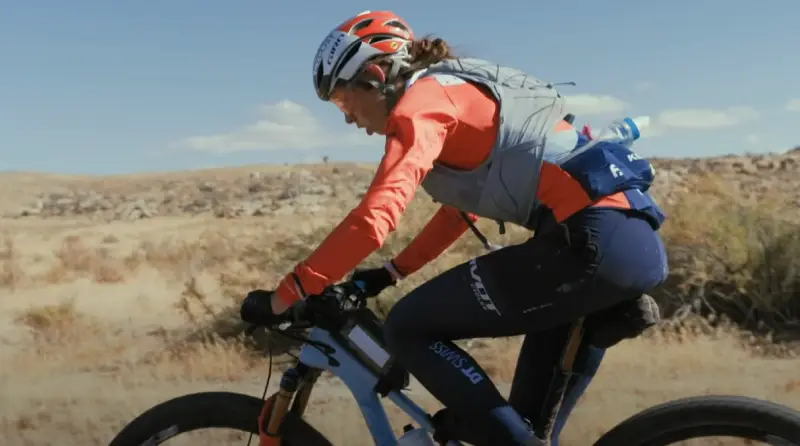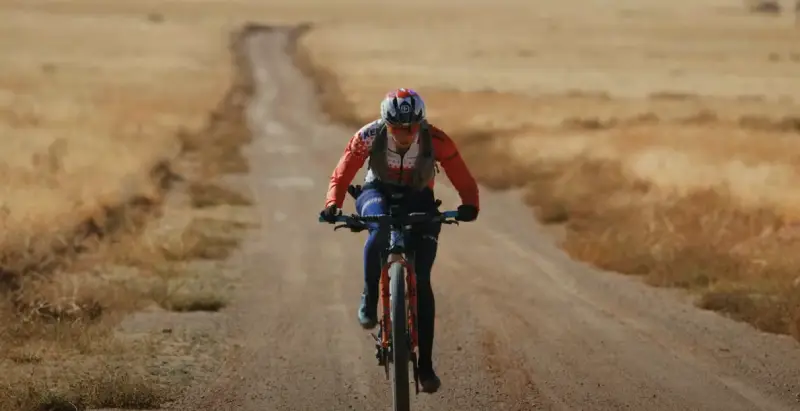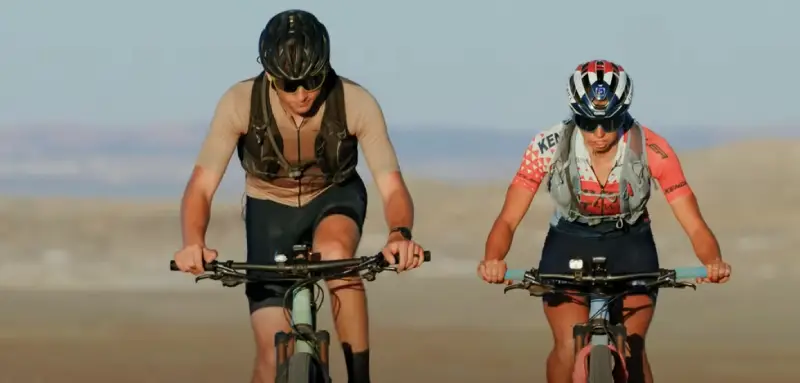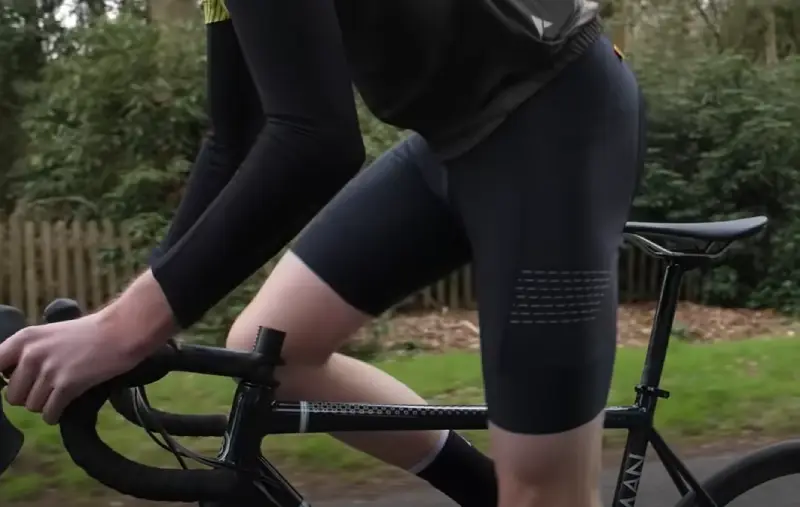Front panels offer wind protection, while some pants are waterproof and windproof. Tights provide less weather protection but better aerodynamics. Certain cycling pants can double as streetwear for easy urban transitions.
For warm weather, opt for cycling shorts made from breathable materials with padded inserts for comfort. In cooler conditions, choose cycling tights for added warmth and muscle support. Ensure both options fit snugly and are made from durable, stretchy fabrics for optimal performance.
In this guide, we’ll delve into the fascinating world of cycling pants, their significance, types of cycling pants with their feature, and how the right pair can transform your ride.
What Pants To Wear Cycling: 3 Factors to Consider

When picking out cycling pants, several important factors must be considered. The right pair can make your ride much more enjoyable. Comfort is key in cycling pants. Let’s talk about comfort here. Let’s dive into what makes cycling pants comfortable.
Comfort in Cycling Pants
Comfort in cycling pants is crucial for any rider. If your pants are uncomfortable, focus more on your discomfort than on enjoying your ride. You can make your cycling pants more comfortable by following these tips.
Ensuring Proper Fit and Mobility
- Fit Matters: Your cycling pants should fit snugly but not too tight. They need to stay in place without restricting your movement.
- Mobility is Key: Make sure the pants allow you to pedal easily. Good cycling pants stretch with your movements so you can ride smoothly.
- Check the Waistband: A comfortable waistband can make a big difference. It should be snug but not dig into your skin.
Padding for Long Rides
- The Chamois: This is the padded part of the cycling pants. As a result, pressure is reduced and shock is absorbed. Look for a chamois that is well-placed and doesn’t move around.
- Thickness and Quality: The padding should be thick enough to provide comfort on long rides. Higher-quality padding often means better comfort and durability.
- Moisture-Wicking Properties: Pads that wick moisture away help prevent chafing during rides.
Breathability and Moisture-wicking Fabric
- Wicking Away Sweat: Moisture-wicking fabrics pull sweat away from the skin, enabling you to stay dry and comfortable.
- Quick-Drying: Fabrics that dry quickly keep you from feeling damp during your ride. Quick-drying materials are especially useful in hot weather.
Durability of Cycling Pants
Durability in cycling pants ensures they withstand regular use and tough conditions. Durable pants save you from frequent replacements and offer consistent performance. Here’s what to look for to ensure your cycling pants are long-lasting.
Material Quality and Longevity
- High-Quality Fabrics: Look for cycling pants made from high-quality materials like nylon or polyester. These materials are known for their strength and durability.
- Stretch and Recovery: The fabric should be able to stretch with your movements and return to its original shape without sagging.
- Reinforced Areas: Check for reinforced stitching or extra layers of fabric in high-stress areas. This adds to the pants’ overall longevity.
Resistance to Wear and Tear
- Abrasion Resistance: Choose pants designed to resist abrasions. This feature is especially important if you ride on rough terrains where your pants might come into contact with branches or rocks.
- Double Stitching: Double-stitched seams are stronger and less likely to rip than single-stitched seams, which can greatly improve the pants’ durability.
- Durable Zippers and Fasteners: High-quality zippers and fasteners that do not break easily are essential. Make sure they are smooth to operate and securely attached.
Weather Appropriateness of Cycling Pants
Weather-appropriate cycling pants ensure you stay comfortable no matter the weather. Whether hot, cold, or rainy, choosing the fitting pants can have a significant impact in your ride.
Selecting Pants for Hot Weather
- Lightweight Materials: For hot weather, choose cycling pants made from lightweight and breathable fabrics. These help keep you cool by allowing air to circulate.
- Moisture-Wicking Properties: Pants with moisture-wicking properties pull sweat away from your skin, staying cool and comfortable.
- Ventilation Features: Look for pants with built-in ventilation-like mesh panels. These features enhance airflow, reducing overheating.
Choosing Pants for Cold Weather
- Insulated Fabrics: Insulated pants are essential for cold rides. Materials like fleece-lined fabrics provide warmth by trapping heat close to the body.
- Layering Capabilities: Consider pants that allow for easy layering. You can add thermal layers underneath for extra warmth.
- Windproof Features: Windproof cycling pants help block cold winds, keeping you warmer during chilly rides.
Pants for Cycling: 4 Specific Types

There are many cycling pants, each designed for different needs and preferences. In this part of the blog, we will focus on bib shorts, a popular choice among cyclists. Let’s explore why they are favored and when they are best used.
Bib Shorts as Cycling Pants
Bib shorts are cycling shorts with straps that go over your shoulders. This design helps keep the shorts in place and adds comfort during rides. Here’s a closer look at the benefits and drawbacks of bib shorts and the ideal conditions for wearing them.
Benefits:
- No Waistband Pressure: Since bib shorts don’t have a waistband, they don’t dig into your stomach, which can be more comfortable, especially on long rides.
- Better Fit: The straps keep the shorts in place, preventing them from slipping or bunching up.
- Improved Comfort: Bib shorts often have better padding, providing extra comfort for long-distance rides.
Drawbacks:
- Bathroom Breaks: Taking off bib shorts for bathroom breaks can be inconvenient, as you must also remove your jersey.
- Heat Retention: In hot weather, the extra fabric of the straps might feel warmer compared to regular shorts.
- Cost: Bib shorts are usually more expensive than traditional cycling shorts.
Ideal Conditions for Wearing Bib Shorts
- Long-Distance Rides: The added comfort and secure fit make bib shorts ideal for long-distance cycling. They reduce the need for adjustments during your ride.
- Race and Training Sessions: The snug fit and enhanced comfort help you perform better without distractions for races and intense training.
- Cool Weather: Bib shorts can be a good choice in cooler weather since they provide extra coverage and warmth around your midsection.
Cargo Pants for Cycling
Multiple pockets are a hallmark of cargo pants, as well as their practical design. They offer many storage options, making them handy for cyclists who need to carry items during their rides. Let’s look at their storage solutions and overall practicality and comfort.
Storage Solutions for Long Rides
- Multiple Pockets: Cargo pants come with many pockets, providing ample storage space for snacks, tools, maps, and other essentials.
- Easy Access: The pockets are designed for easy access while riding, so you don’t have to stop whenever you need something.
- Secure Storage: Many cargo pants feature zippered or buttoned pockets, ensuring your items stay safe and don’t fall out during your ride.
Practicality and Comfort
- Comfortable Fit: Look for cargo pants with a comfortable fit for free movement. Some designs include adjustable waistbands and stretchy fabrics for added comfort.
- Versatility: Cargo pants are suitable for both on and off the bike. They can easily transition from a cycling adventure to casual wear, making them highly versatile.
- Weather Resistance: Many cargo pants offer water resistance and wind protection, making them practical for different weather conditions.
Tights and Leggings for Cycling
Tights and leggings offer excellent coverage and support for cyclists. They are also designed to keep you warm in cold weather and provide additional benefits like compression. Let’s explore their uses and advantages.
Winter and Cold Weather Use
- Insulation: Tights and leggings are often made with thermal materials that provide insulation, keeping your legs warm during cold rides.
- Full Coverage: These pants protect your entire leg from the wind and cold air, making them ideal for winter cycling.
- Layering: You can easily layer other garments over or under tights and leggings for added warmth without feeling bulky.
Compression Benefits
- Increased Blood Flow: Compression tights help improve blood circulation in your legs. This can reduce muscle fatigue and enhance your performance.
- Muscle Support: Compression leggings’ snug fit supports your muscles, reducing injury risk and helping with recovery post-ride.
- Reduced Vibration: Compression materials minimize muscle vibrations during cycling, which can lessen soreness and improve comfort.
Baggy shorts are designed for mountain biking, providing both style and protection. Unlike tight-fitting cycling shorts, baggy shorts offer a relaxed fit. Here’s why they are a good choice for off-road adventures.
Extra Protection and Style
- More Coverage: Baggy shorts provide extra coverage, protecting your legs from branches, rocks, and other trail hazards.
- Stylish Look: These shorts offer a more casual and stylish look than traditional cycling shorts. You can easily wear them off the bike as well.
- Durable Fabric: Baggy shorts are usually made from tough materials that withstand rough conditions and frequent falls, making them perfect for mountain biking.
Comfort and Flexibility Off-Road
- Freedom of Movement: The loose fit of baggy shorts allows for greater freedom of movement, essential for navigating tricky trails.
- Comfortable Padding: Many baggy shorts have built-in padding or liners, which provide comfort on bumpy rides without compromising flexibility.
- Breathability: These shorts often feature breathable fabrics and panels for ventilation during intense rides.
Men’s And Women’s Cycling Pants: Special Features

Cycling attire is not universally sized. Men and women require distinct cycling gear tailored to their specific needs. Here, we delve into the realm of specialized cycling pants for both genders, accentuating their unique characteristics.
Men’s Cycling Pants
Men’s cycling pants are designed with specific anatomical and style preferences in mind. Let’s look at how these pants cater to men’s needs.
Anatomical Differences and Design
- Padding Placement: Men’s cycling pants often feature padding (chamois) that is placed to support the male anatomy. This helps reduce pressure and increases comfort during long rides.
- Waistband Design: The waistband on men’s pants is typically higher in the back and lower in the front to provide a comfortable fit without digging into the stomach.
- Leg Length and Fit: Men’s cycling pants usually have longer leg lengths and a looser fit around the thighs, providing better coverage and freedom of movement.
Style Preferences and Functionality
- Color Choices: Men’s cycling pants come in a variety of patterns and colors, catering to different style preferences while maintaining functionality.
- Pocket Placement: Pockets on men’s pants are often designed for easy access to essentials like energy bars, phones, or tools during the ride.
- Durability: Men’s cycling pants are made from materials that are durable, ensuring they last longer.
Women’s Cycling Pants
Cycling pants for women offer a comfortable and practical fit for female cyclists. Let’s delve into how these pants cater to women’s needs.
Tailored Fits and Comfort Features
- Anatomical Design: Women’s cycling pants are designed to fit the female body shape. They often feature a wider hip area and a narrower waist for better comfort.
- Padding Placement: The padding (chamois) in women’s pants is strategically placed to support the female anatomy, reducing pressure points and enhancing comfort on long rides.
- Adjustable Waistbands: Many women’s cycling pants come with adjustable waistbands for a custom fit, ensuring they stay in place without digging into the skin.
Addressing Common Issues like Chafing
- Seamless Construction: To reduce chafing, many women’s cycling pants use flatlock seams or seamless construction techniques. This helps prevent skin irritation during long rides.
- Moisture-Wicking Materials: Fabrics that wick away moisture help keep the skin dry, reducing the risk of chafing caused by sweat.
- Proper Fit: A well-fitting pair of pants reduces bunching and friction, which are common causes of chafing. Look for pants with a snug but comfortable fit.
Modern Cycling Pants: 2 Additional Features

Modern cycling pants come with a range of features that enhance comfort, performance, and safety. One important feature is the inclusion of reflective elements. In this section, we will discuss how reflective elements improve visibility and safety, as well as their integration into the design.
Reflective Elements in Cycling Pants
Reflective elements are small, shiny details added to cycling pants. These elements help make cyclists more visible to others, especially in low light conditions. Here’s why they are important and how they are integrated into modern designs.
Enhancing Visibility and Safety
- Increased Visibility: Reflective elements catch and reflect light from car headlights, making cyclists more visible during early morning or evening rides.
- Safety in Low Light: Wearing pants with reflective details helps drivers see cyclists from a distance, reducing the risk of accidents.
- 360-Degree Visibility: Some cycling pants feature reflective strips on all sides—front, back, and sides—offering better overall visibility.
Integration with Design
- Aesthetic Appeal: Reflective elements are often seamlessly integrated into the design of the pants, adding style without being too obvious during daylight.
- Strategic Placement: These elements are placed in key areas, such as the lower legs, hips, and seams, where they are most effective at catching light and grabbing attention.
- Durable Materials: Reflective elements are made from durable materials that withstand wash and wear, ensuring they remain effective for the life of the pants.
Zippers, Pockets, and Adjustable Waistbands
Cycling pants have evolved to include practical elements like pockets, zippers,and adjustable waistbands. These features help make your ride more comfortable and efficient. Let’s look at their benefits.
Convenience and Versatility
- Zippered Ankles: Zippers at the ankles make it easy to put on and take off the pants, especially over cycling shoes. They also allow for better ventilation on warmer days.
- Multiple Pockets: Having several pockets provides space to store essentials like keys, phones, and snacks. This means you don’t have to carry extra bags.
- Adjustable Waistbands: Adjustable waistbands ensure a secure and comfortable fit. They allow you to customize the tightness, which can be helpful as you move and shift positions during your ride.
Practical Use Cases
- Long Rides: On long rides, zippered pockets can keep your items safe and secure. You can access them easily without having to stop.
- Commuting: For daily commuting, adjustable waistbands and multiple pockets make it easier to carry what you need while staying comfortable throughout your journey.
- Changing Weather: Zippers at the ankles or along the sides can help adjust ventilation as the weather changes, keeping you comfortable in different conditions.
Conclusion
In conclusion, cycling pants encompass more than meets the eye. Each aspect we’ve covered, from the pant type to its breathability, comfort, and weather suitability, significantly influences your ride experience.
Ultimately, the finest cycling pants are those that instill confidence, ensure comfort, and prepare you for any journey, irrespective of the route or weather conditions. So, secure your helmet, slip into your carefully chosen cycling pants, and gear up to conquer the cycling realm, one ride at a time.
FAQs
Which Fabric Is Best For Cycling?
Cotton tends to be quite uncomfortable as it absorbs moisture, retaining it close to your body during rides. On the other hand, polyester fabrics offer breathability and effectively wick moisture away from your body while cycling, ensuring you stay dry and warm.

![Cycling Pants 3 Factors and 4 Specific Types [with Features]](https://cacyclinghub.com/wp-content/uploads/2025/07/Cycling-Pants-3-Factors-and-4-Specific-Types-with-Features.jpg)
